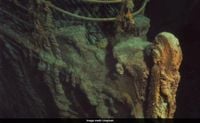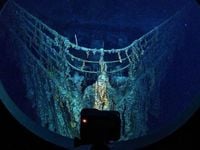Forty years ago, in the early hours of September 1, 1985, a handful of scientists and crew aboard the research vessel Knorr stared at a grainy black-and-white video feed, transfixed. The screen showed a metal cylinder resting on the Atlantic seafloor, about 13,000 feet (3,900 meters) beneath the waves. The object looked eerily familiar to the four-person watch team: could it be a sunken ship’s boiler? Unable to contain their excitement, the team dispatched the ship’s cook to wake up Bob Ballard, the expedition’s chief scientist, who had been chasing the Titanic’s ghost since the 1970s. Ballard, as he later told CNN, was already awake in his cabin, reading. "The cook didn’t even finish his sentence. I jumped out. I literally put my flight suit over my pajamas, which I didn’t take off for several days after that," he recalled.
Ballard, then a senior scientist emeritus in applied ocean physics and engineering at the Woods Hole Oceanographic Institution in Massachusetts, rushed to the command center. There, the team compared the video with a photo of the Titanic’s boiler pinned to the wall. The realization hit: they had found the world’s most famous shipwreck. "We realized it was definitely (from the) Titanic, and all bedlam grew loose," Ballard said.
The Titanic’s allure had endured for more than seven decades. When the so-called "unsinkable" ship went down on its maiden voyage in 1912, it carried some of America’s wealthiest citizens, and became a symbol of human arrogance, class prejudice, and technological overreach. By the time Ballard’s team found the wreck 73 years later, the Titanic had become a legend, its mystique growing with every passing year. The 1985 discovery only intensified the public’s fascination, inspiring a blockbuster 1997 film, countless documentaries, museum exhibits, and—more recently—pricey, high-risk expeditions to visit the site, one of which ended in tragedy in 2023, according to CNN.
But what the world didn’t know at the time was that Ballard’s celebrated search for the Titanic was actually a cover for a top-secret Cold War military operation. As Ballard revealed to CNN, "What people didn’t know at the time, at least a lot of the people, was that the Titanic (search) was cover for a top-secret military operation I was doing as a naval intelligence officer. We didn’t want the Soviets to know where the submarine was." The U.S. Navy had funded Ballard’s deep-sea imaging system, nicknamed Argo, not just to look for the Titanic, but to locate and investigate the wrecks of two nuclear submarines—the USS Thresher and USS Scorpion—lost in the Atlantic during the 1960s. Ballard convinced Navy officials to let him search for the Titanic during the same mission, cleverly using the shipwreck as a smokescreen for Cold War intelligence work.
Ballard’s journey to this moment had not been straightforward. His first attempt to find the Titanic, in 1977, ended in disappointment when a 3,000-foot drilling pipe snapped, according to his memoir "Into the Deep." This setback, and the need for real-time imagery, pushed Ballard to develop remotely operated underwater vehicles (ROVs) that could stream video back to the surface. The Navy’s backing was crucial, and Argo became the technological centerpiece of the 1985 expedition.
The search itself was a race against time. A French team, led by Jean-Louis Michel of IFREMER, was initially expected to locate the wreck using advanced sonar, with Ballard’s group set to film it afterward. But the French missed the mark, and Ballard’s “camera on a string” ultimately made the discovery, aided by a crucial insight. While mapping the debris of the Scorpion submarine, Ballard realized that debris fields—trails of lighter wreckage carried by ocean currents—were much larger and easier to find than the main hull. Applying this logic to the Titanic, his team focused on searching for the debris field rather than the ship itself. Dana Yoerger, a Woods Hole senior scientist in marine robotics, explained, "The big thing that led to our success was Ballard’s strategy. He wasn’t trying to find the ship, he was trying to find the debris field, which is a much bigger target, and one that’s particularly well-suited to finding with your eyeballs."
Argo’s black-and-white video in 1985 was soon followed by still images captured by an older system called ANGUS. These blue-hued photographs confirmed the wreck’s existence. The following year, Ballard’s team returned with advanced color cameras and recorded iconic images of the ship’s swimming pool, grand staircase, and the unmistakable bow. Ballard himself became the first person to visit the wreck in person, descending in the Alvin submersible for a two-hour journey to the ocean floor. Down there, he saw haunting artifacts—a child’s doll, uncorked champagne bottles, silverware—but, as he noted, no human remains.
One peculiar feature caught Ballard’s eye: long, reddish spikes formed by bacteria feeding on the Titanic’s metal. He dubbed these formations “rusticles,” a term that later made its way into the Oxford English Dictionary. Some areas of the ship, protected by pink paint applied during construction, remained remarkably pristine. Ballard advocated for using similar protective methods—perhaps applied by underwater robots—to preserve what he called "very hallowed ground."
The Titanic’s discovery revolutionized deep-sea exploration. The prototype technology developed for the mission, and the strategic thinking behind it, opened new frontiers for ocean science. Ballard’s subsequent expeditions yielded even more scientific breakthroughs. His work along the Mid-Atlantic Ridge provided crucial evidence for plate tectonics, and his dives to the Galápagos Rift revealed hydrothermal vents teeming with life—proof that life could exist without sunlight and a discovery that rewrote biology textbooks.
Ballard’s knack for finding lost vessels didn’t stop with the Titanic. He later located the Nazi warship Bismarck, the aircraft carrier USS Yorktown, and PT-109, the Navy boat once commanded by a young John F. Kennedy. Not every quest ended in triumph; in 2019, Ballard’s search for Amelia Earhart’s missing plane came up empty. "It’s still on our checkbox," he told CNN, expressing hope that new technologies will eventually solve the mystery.
Even at 83, Ballard remains an active force in ocean exploration. In July 2025, he returned from a 21-day expedition aboard the Nautilus, mapping World War II shipwrecks in the Solomon Islands—evidence that his curiosity is as fierce as ever. "I love it when kids tell me to stop discovering things, so there’s something left for them to find," he quipped. Yet, he’s confident that the ocean holds countless secrets for the next generation of explorers.
From the cold depths of the Atlantic to the latest underwater robotics, the story of the Titanic’s discovery is as much about human ingenuity and persistence as it is about the mysteries of the sea. The legacy of that night in 1985 continues to inspire, reminding us that, sometimes, the greatest discoveries are the ones hidden in plain sight.



